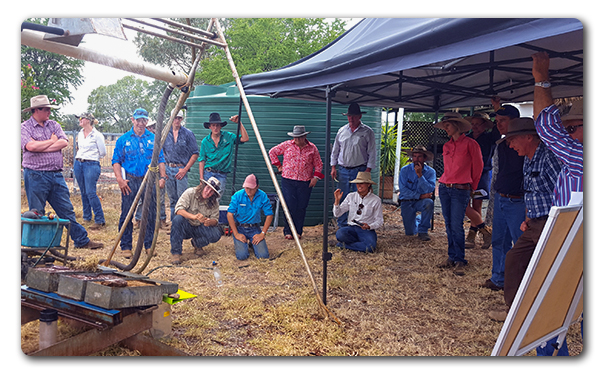Burdekin graziers learn key tips for improving soil health
Twenty-three North Queensland graziers from 15 enterprises learnt about the importance of good soil health at a series of three NQ Dry Tropics Building Healthy Soils workshops last week. They discovered what makes soil healthy, how to tell if it’s alive, how to re-energise it, and how to make positive changes for their grazing business.
The graziers, who collectively manage around 204,000 hectares, were joined by 10 students from the Emerald Agricultural College – the next generation. The workshops were hosted by the Murray family at Oaklands Station via Balfes Creek, the Sullivan family at Mt Coolon Station and the Bauman family at Monkland Station, via Alpha. They were delivered through two NQ Dry Tropics projects: Sustainable Soils for the Burdekin, and Saving Our Soils Burdekin.
Linda Anderson, NQ Dry Tropics Project Officer, said: “These projects focus on increasing graziers’ skills and knowledge to improve their businesses, and cattle and grass management practices. They are funded under the Australian Government’s National Landcare Programme, and the Australian Government Reef Trust through the Queensland Government Department of Environment and Heritage Protection.
“NQ Dry Tropics helps graziers to implement changes that improve management practices and productivity, while reducing agricultural runoff into the Great Barrier Reef lagoon,” Linda said.
Attendees discussed issues including the pros and cons of using fire as a management tool, how carbon helps to create healthy soils, and how to grow more grass to protect topsoil, promote better nutrient cycling and encourage good soil microbial activity.
Juliet McConachie, KiaOra Station, Alpha, commented: “We need to look at minimising our use of fire, and increasing spelling periods and grazing management to make our soils more healthy.”
A highlight of the day was the rainfall simulation, presented by Peter Burger, Field Scientist at the Department of Natural Resources and Mines (DNRM). He said: “The in-field rainfall simulation demonstrates and compares filtration, ponding and runoff characteristics of different local soil types and ground covers.

Rainfall simulation at Monklands Station demonstrating and comparing filtration, ponding and runoff characteristics of different soil types and ground covers.
“We had a spectacular result at Mt Coolon, where a bare sodic gully sample glazed over and runoff occurred after a 5 mm in 2 minute rainfall burst. We pushed this out to a 45 mm in 16 minute demonstration, resulting in a total runoff of 33 mm. The demonstration showed how low infiltration rates of sodic soils can be, and how quickly bare sodic soils can create runoff,” Peter said.
Other key presenters included Kristy Youman, who provided hands-on, practical approaches to understanding and measuring the basic biology of soils and soil life, and Mick Alexander who focused on how soil health impacts on profitability and productivity in the grazing industry.
Bec Comiskey, Melton Station, Alpha, reflected: “The hands on demonstration in the soil pit, showing how to measure root depth, soil texture and pH was a standout of the day – as was the role play showing us the relationships between soil critters and chemistry.’
Main photos: Kristy Youman, Soil Land Food, showing Aaron and Zander M. how to test soil pH at Oaklands Station, Balfes Creek (L); Mick Alexander discusses soil health and pasture production Denton Sullivan and Mick Clark at Mt Coolon Station (R).
